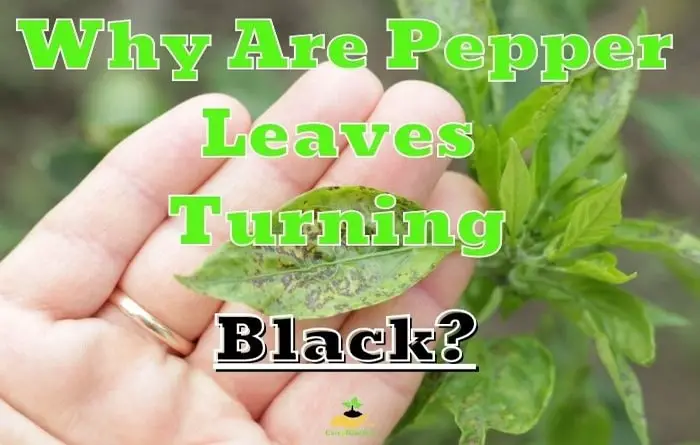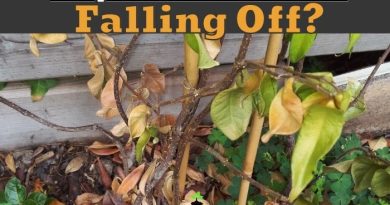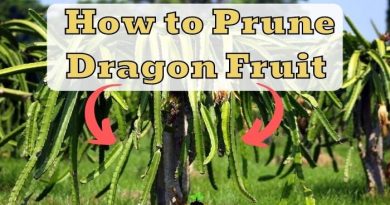Why Are My Pepper Leaves Turning Black? (Here Is The Answer)
Pepper plants are a popular choice for home gardeners due to their delicious fruits and ease of cultivation. However, one common issue when growing peppers, gardeners like myself can face is: the pepper leaves are turning black.
Black leaves on pepper plants can be a sign of a serious problem, so it’s crucial to understand the causes and how to address them to ensure the health of your plants. In this article, we’ll explore the reasons why pepper leaves are turning black and how to remedy the situation.
If your pepper leaves are turning black, it could be due to a number of factors, including overwatering, poor drainage, fungal diseases, pests, nutrient deficiencies, or environmental stressors. To prevent black leaves, make sure your pepper plants are getting enough water and nutrients, and avoid over-fertilizing. If you notice black spots on your pepper leaves, try removing affected leaves and treating your plants with a fungicide. Consult a gardening expert for more personalized advice.
Causes for black leaves on pepper plants
1.Overwatering and poor drainage
Overwatering and poor drainage are common causes of black leaves on pepper plants. When soil is constantly wet, it can lead to root rot and other fungal diseases that prevent the plant from absorbing nutrients properly. Overwatering can also cause the soil to become compacted, which makes it difficult for air to circulate through the roots.
To prevent overwatering and poor drainage, it’s important to make sure that the soil is well-drained and that water is not allowed to sit in the saucer or tray beneath the plant.
Water only when the top inch of soil is dry to the touch, and be sure to use a pot with drainage holes to allow excess water to escape. If you’re growing peppers in the ground, consider adding organic matter like compost to improve drainage and aeration.
If you suspect that your pepper plant is suffering from overwatering or poor drainage, it’s important to take action as soon as possible.
Remove any standing water from the saucer or tray beneath the plant, and consider repotting the plant in fresh, well-draining soil. If the roots are severely damaged, you may need to prune them back or even start over with a new plant.
2.Water deficiency
Often, pepper leaves turn black due to infrequent and insufficient watering. Lack of water in the soil leads to the fact that pepper leaves begin to wither, turn black and dry.
Pepper plants are moisture-loving, so regular watering for their healthy development and fruiting is extremely important. Moreover, the bushes should be watered with warm water in the morning or evening hours, when the sun’s rays do not fall on the plants.
It is important for gardeners to remember that pepper is a culture that requires frequent and fairly abundant watering. If the soil is not provided with sufficient moisture, it can lead to the death of agricultural crops.
In this case, it is recommended to carefully monitor the watering and the amount of water. Light wetting of the soil is not enough for normal growth of pepper, it needs good watering.
It is important that the root system is completely wet, because this is the only way to save the seedlings. Do not forget about loosening the soil crust – a necessary action to obtain oxygen.
3.Fungal diseases
Fungal diseases are another common reason why pepper plant’s leaves are turning black. Several types of fungal diseases can infect pepper plants, including anthracnose, verticillium wilt, and powdery mildew. These diseases can cause the leaves to turn black or brown and become dry or brittle.
Anthracnose is a fungal disease that causes black, sunken lesions on the leaves and stems of pepper plants. This disease is caused by the fungus Colletotrichum capsici and thrives in warm and humid conditions. Overcrowding and poor air circulation can also contribute to the development of anthracnose.
Verticillium wilt is another fungal disease that can cause black leaves on pepper plants. This disease is caused by the fungus Verticillium dahliae and can be identified by the yellowing of the leaves followed by their eventual death. The fungus can survive in the soil for several years and can infect pepper plants through their roots.
Powdery mildew is a common fungal disease that affects a wide range of plants, including pepper plants. This disease can cause the leaves to turn black or brown and become covered in a white powdery substance. Powdery mildew thrives in humid conditions and can be spread by water splashing or wind.
To prevent and treat fungal diseases, it is important to keep the plants healthy and stress-free. This includes providing adequate air circulation, avoiding overcrowding, and watering the plants at the base to prevent water from sitting on the leaves.
Fungicides may also be used to treat plants, but it is important to choose a product that is safe for edible plants and follow the instructions carefully.
Table with the disease that causes peppers leaves to turn black and how to treat.
| Disease | Signs of Plant Damage | Treatment |
|---|---|---|
| Phytophthora blight | Blackened stems and leaves, wilting, root rot | Remove infected plants and debris, avoid overhead watering, and apply fungicide. |
| Bacterial leaf spot | Black or dark brown spots on leaves, lesions on stems and fruit | Remove infected plants and debris, avoid overhead watering, apply copper-based fungicide or bactericide. |
| Anthracnose | Black or brown sunken spots on leaves, stems, and fruit | Remove infected plants and debris, avoid overhead watering, and apply fungicide. |
| Verticillium wilt | Yellowing and wilting of lower leaves, stunted growth, dark streaks in stems | Remove infected plants and debris, avoid overhead watering, and use resistant varieties. |
| Fusarium wilt | Yellowing and wilting of leaves, stunted growth, brown streaks in stems | Remove infected plants and debris, avoid overhead watering, use resistant varieties, and apply fungicide. |
Phytophthora blight
One of the most common causes of blackening of pepper leaves is a fungal or bacterial infection called Phytophthora late blight. Late blight refers to fungal diseases and the source of infection in this case is the soil. The peak incidence occurs in the second half of summer during the fruiting period of peppers.
Fungi primarily attack the pepper root system and the whole plant will be affected:
- The stem, fruits and leaves are covered with dark brown spots. The size of the spots can be very different.
- A whitish fluffy coating appears on the spots. These are fungal spores.
Improper agricultural practices and weather conditions like the one specified below can lead to the development of this disease:
- Dense landings;
- Cold watering;
- Dampness and high humidity;
- Cold rainy weather.
Treatment
Regular fertilization of the soil with potassium-phosphorus top dressing to strengthen the plant’s defenses. At the first signs of the disease, it is necessary to treat the pepper bushes with an iodine solution.
Add 10 ml of iodine to 2 liters of water. It is imperative to carry out pre-sowing treatment by soaking the seeds in a manganese solution for 20 minutes.
For spraying diseased plants, you can use an infusion of garlic: 2 heads of minced garlic + 1 tbsp. mustard + 1 tbsp. ground red pepper in 2 liters of water. Apply this infusion for a day.
Then strain the composition and dilute in a bucket of water. Spray the plants every 10 days, starting from the 14th day from transplanting into the garden. This remedy is also effective for pests.
Black Bacterial Leaf Spot
Bacterial diseases, such as black bacterial leaf spot, will leave your pepper plant with brown or black spots, as well as raised bumps.
Usually, Bacterial Leaf Spot attacks young pepper bushes and seedlings. The nature of this sore is bacterial, the causative agent is Xanthomonas arboricola. Even the smallest damage to the pepper leaves is a facilitator environment for the activation of this disease.
At first, watery spots can be found on the leaf plates, petioles, fruits, which darken and grow over time, taking on an irregular rounded shape. The spots are surrounded by a yellow outline.
The pathogens live in the seeds. If the planting material is not soaked in hot water 140°F (60 °C), potassium permanganate or a disinfectant before sowing, the plant is doomed. Also, bacteria can infect already adult bushes, penetrating inside the plant through injuries on the leaves.
After infection, the first symptoms are noticeable already for 3-5 days. High humidity and heat 77-82°F (25-30°C) are a favorable environment for the development of infection.
Treatment
At the first sign of the disease, it is necessary to remove the affected leaves. This disease can be treated with copper-containing bactericides: 1% of Bordeaux liquid. Treatment should be carried out on the leaves.
You should also carry out the prevention of the disease:
- Do not thicken the landing;
- Treat pepper seeds before sowing;
4.Insects and pests
Insects and pests can also cause black leaves on pepper plants. Some common culprits include spider mites, aphids, and thrips. These pests feed on the sap of the pepper plant, which can cause leaves to turn black and wilt. In addition, they can also spread diseases to the plant, leading to further damage.
To identify if pests are causing black leaves on your pepper plants, inspect the leaves for signs of infestation. Look for tiny insects, webbing, or distorted growth. You may also notice a sticky residue on the leaves or underneath the plant, which is a sign of insect feeding.
To treat insect infestations, try using natural remedies such as insecticidal soap, neem oil, or horticultural oil. These products are less harmful to the environment and can effectively control the pest population. You can also try removing the affected leaves or using sticky traps to catch the insects.
Prevention is also key when it comes to insect and pest infestations. Keep your plants healthy and well-maintained to reduce the risk of infestation. Avoid over-fertilizing or using too many pesticides, as this can harm beneficial insects and disrupt the ecosystem of your garden.
Spider Mites
The most common pests that causes pepper leaves to turn black are spider mites. This tiny and almost invisible pest settle in warm, stuffy and humid rooms like greenhouses, where the ideal climate is created for them: hot, humid and stuffy. But they also breed in open ground, especially in dry summers.
To get rid of the spider mites, it is necessary to spray the pepper plant with special preparations. It is better to do this several times during the season: immediately after planting the seedlings, before the fruits appear, after harvesting.
5.Nutrient deficiencies
Pepper plants need a balanced diet to grow healthy, and a lack of essential nutrients can cause black leaves.
Here are some common nutrient deficiencies that can lead to this issue:
| Nutrient Deficiency | Symptoms | Treatment |
|---|---|---|
| Nitrogen | Older leaves turn black and fall off, while new growth is stunted and yellowish-green. | Apply a nitrogen-rich fertilizer, such as blood meal or fish emulsion, and water regularly. |
| Magnesium | Leaves turn black from the bottom up, while veins remain green. | Apply magnesium sulfate (Epsom salt) or a balanced fertilizer containing magnesium. |
| Iron | Younger leaves turn black, while veins remain green. | Apply an iron-rich fertilizer or foliar spray, and maintain proper soil pH (around 6.5). |
| Potassium | Older leaves turn black around the edges, while new growth is stunted and yellowish-green. | Apply a potassium-rich fertilizer, such as wood ash or potassium sulfate, and maintain proper soil pH (around 6.5). |
| Calcium | Leaves turn black at the tips and edges, and may curl or twist. | Apply a calcium-rich fertilizer, such as gypsum or lime, and maintain proper soil pH (around 6.5). |
Nitrogen deficiency
Nitrogen is a crucial nutrient for plant growth, and its deficiency can cause the yellowing of leaves, stunted growth, and blackened edges. To fix this issue, you can fertilize your pepper plants with nitrogen-rich fertilizers such as coffee grounds, fish emulsion, blood meal, or compost.
Phosphorus deficiency
Phosphorus is necessary for root growth, flowering, and fruit production. The lack of phosphorus can lead to the development of black spots on pepper leaves and stems, weak stems, and stunted growth. To solve this issue, you can use fertilizers containing phosphorus, such as bone meal or rock phosphate.
Potassium deficiency
Potassium is required for the proper functioning of plants, including water uptake, photosynthesis, and disease resistance. The lack of potassium can cause pepper leaf edges to turn black, along with yellowing, curling, and drooping leaves. To fix this issue, you can use fertilizers containing potassium, such as wood ash or kelp meal.
Calcium deficiency
Calcium is important for cell wall development and plant structure. Its deficiency can cause black spots on the leaves, stem rot, and blossom-end rot in fruits. To solve this issue, you can use calcium-rich fertilizers, such as gypsum or eggshells.
Magnesium deficiency
Magnesium is needed for the production of chlorophyll, the green pigment in leaves that is essential for photosynthesis. Its deficiency can cause yellowing of the leaves, with black veins and edges. To fix this issue, you can use magnesium-rich fertilizers, such as Epsom salts or dolomitic lime.
It is important to note that excessive use of fertilizers can also cause nutrient imbalances and lead to black leaves. Therefore, it is recommended to use fertilizers in moderation and based on the plant’s needs.
6.Environmental stressors
Pepper plants are sensitive to environmental changes, and exposure to certain stressors can lead to black leaves. Here are some common environmental stressors to be aware of:
Sudden temperature changes
High temperatures can cause leaf scorching, which can turn the leaves black. Low temperatures can cause frost damage, which can also lead to blackened leaves. Protect pepper plants from extreme temperatures by providing shade or covering them during hot or cold spells.
Peppers love warmth and comfort: 77°F (+25°С) during the day and 60°F (+16°С) at night is the ideal temperature for them. However, when the night temperature drops below 54°F (+12°C), the peppers “freeze”.
At the same time, their foliage can change color to dark. So the creation of a normal microclimate for this culture is a must! If it gets colder early in your area, then peppers must be planted in a greenhouse.
Both sweet and hot peppers do not like sudden temperature changes. The plant culture is especially negative about frosts. If the plant “freezes”, then its leaves begin to turn black, fruiting will decrease.
Chemical exposure
Exposure to chemicals, such as pesticides or herbicides, can cause pepper leaves to turn black. Avoid using chemical sprays near your pepper plants, or use natural alternatives if possible.
Soil compaction
Compacted soil can limit water and nutrient uptake, which can stress the plant and cause black leaves. To prevent soil compaction, avoid stepping on the soil around your pepper plants and use mulch to improve soil structure.
Sunburn
Sunburn is another reason why your peppers may have black spots. The intense heat of summer can affect your peppers, giving them black spots where the sun is most prominent on the peppers.
Think of it like sun spots on the skin from prolonged exposure to the sun. To avoid this, move your peppers to a shadier area or cover them with a cloth during hot sunny days.
To prevent black leaves from environmental stressors, it’s important to monitor the temperature, avoid chemical exposure, and maintain healthy soil conditions.
How to Prevent Black Leaves on Peppers
To prevent pepper leaves from turning black you should consider the most practical and effective actions:
1.Often the seedlings themselves are infected with an infectious disease, so immediately after planting they begin to drop their leaves. It is better to give preference to specialized stores rather than spontaneous markets.
2.Pepper is a moisture-loving culture, so it cannot exist for a long time without water.
3.Avoid watering peppers with cold water. Supercooled soil is a favorable habitat for pathogenic microorganisms. Watering heat-loving plants is carried out only with warm water.
4.You should not plant pepper near those plants that are prone to pest attacks and infections.
5.Always pay attention to sprinkling, application of mineral or organic fertilizers. Without it, it is impossible to get a good harvest.
6.Before sowing, it is required to carry out disinfection treatment of manually collected seeds. To do this, the seeds are soaked in a slightly pink solution of potassium permanganate for 3 hours.
7.Regularly loosen the soil around the peppers. This will help to avoid waterlogging of the soil and prevent blackening of the leaves.
8.Timely remove weeds and plant residues from the rows, to prevent rotting of plants on the soil surface.
9.Ventilate the greenhouse regularly, especially in hot weather. Ventilation is carried out during the day. Do not open the greenhouse door at night.
Conclusion
Pepper leaves turning black always indicates a problem. Bacterial or fungal infections, as well as improper plant care, can provoke the appearance of such a symptom.
Diseases and insufficient care and improper microclimate in pepper are primarily reflected in the foliage.
If suddenly the pepper leaves start turning black, you don’t need to worry because I have shown you the methods to save not only the diseased bush, but also the rest of the plantings.
Frequently Asked Questions
If your pepper plants have black leaves, you should immediately remove the infected leaves or plants and dispose of them properly. It’s important to identify the specific disease and use the appropriate treatment. This may include the use of fungicides or bactericides, switching to resistant varieties, and improving cultural practices such as proper sanitation and watering.
It depends on the severity of the disease and the extent of the damage. If the disease has progressed significantly and the plant is severely affected, it may not be possible to save it. However, if caught early and treated promptly, the plant may be able to recover.
Yes, overwatering can cause pepper leaves to turn black. Overwatering can lead to root rot and other fungal diseases that can cause blackening of leaves. To avoid overwatering, make sure the soil is well-draining and allow it to dry out between watering sessions. Also, avoid overhead watering as it can lead to the spread of diseases.
To determine if your pepper plants have a disease that’s causing black leaves, you should look for other symptoms such as wilting, yellowing, or stunted growth. Additionally, inspect the leaves closely for any lesions, spots, or discoloration. It’s also important to identify the specific disease to determine the appropriate treatment. You can consult with a plant expert or use online resources to help identify the disease.




